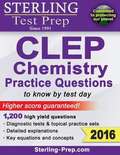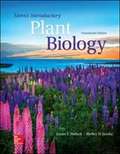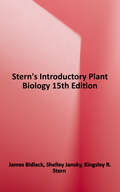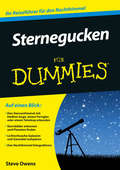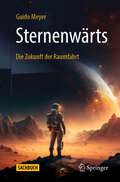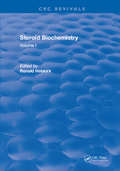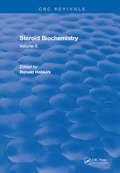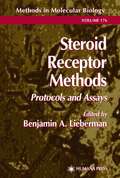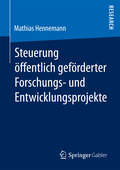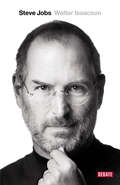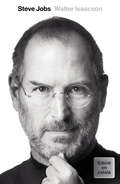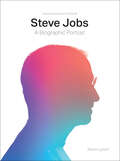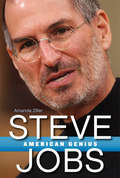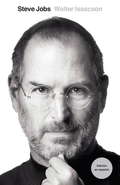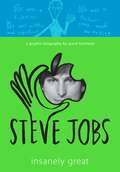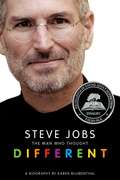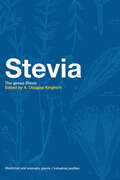- Table View
- List View
Sterilization of Medical Devices
by Anne BoothThis book presents vital information on international sterilization standards and guidance on practical application of these standards in the manufacturing process. It covers validation, industrial sterilization methods, emerging sterilization techniques, laboratory testing, manufacturing of sterile devices, and device reuse. Excerpted from The Validator, edited by Anne F. Booth, more than fifty experts share their knowledge of current technologies in easy-to-understand articles that establish methods to ensure compliance. Contents include reviews of ISO sterilization standards, industrial sterilization methods and technologies, and support testing methodologies.
Sterilized by the State
by Randall Hansen Desmond KingThis book is the first comprehensive analysis of eugenics in North America focused on the second half of the twentieth century. Based on new research, Randall Hansen and Desmond King show why eugenic sterilization policies persisted after the 1940s in the United States and Canada. Through extensive archival research, King and Hansen show how both superintendents at homes for the 'feebleminded' and pro-sterilization advocates repositioned themselves after 1945 to avoid the taint of Nazi eugenics. Drawing on interviews with victims of sterilization and primary documents, this book traces the post-1940s development of eugenic policy and shows that both eugenic arguments and committed eugenicists informed population, welfare, and birth control policy in postwar America. In providing revisionist histories of the choice movement, the anti-population growth movement, and the Great Society programs, this book contributes to public policy and political and intellectual history.
Sterling Test Prep: Practice Questions with detailed explanations 6th edition
by The Editors at the Sterling PrepThis book provides over 1,800 chemistry practice questions that test your knowledge of all CLEP Chemistry topics.
Stern's Introductory Plant Biology
by Kingsley R. Stern Shelley Jansky James BidlackThis introductory text assumes little prior scientific knowledge on the part of the student. It includes sufficient information for some shorter introductory botany courses open to both majors and nonmajors, and is arranged so that certain sections can be omitted without disrupting the overall continuity of the course. Stern emphasizes current interests while presenting basic botanical principles. This latest edition incorporates measurable learning outcomes and updated readings. Students will be introduced to the new classification of plants and plant-related species, integration of biotechnology into several chapters and inclusion of new text boxes addressing the areas of ecology, evolution and molecular biology. New photos have replaced older pictures or have been added also.
Stern's Introductory Plant Biology
by Kingsley R. Stern James E. Bidlack Shelley H. JanskyThis introductory text assumes little prior scientific knowledge on the part of the student. It includes sufficient information for some shorter introductory botany courses open to both majors and nonmajors, and is arranged so that certain sections can be omitted without disrupting the overall continuity of the course. Stern emphasizes current interests while presenting basic botanical principles. This latest edition incorporates measurable learning outcomes and updated readings. Students will be introduced to the new classification of plants and plant-related species, integration of biotechnology into several chapters and inclusion of new text boxes addressing the areas of ecology, evolution and molecular biology. New photos have replaced older pictures or have been added also. <P><P> With this edition we introduce McGraw-Hill Connect® Botany, a web-based assignment and assessment platform that gives students the means to better connect with their coursework, with their instructors, and with the important concepts that they will need to know for success now and in the future. With McGraw-Hill Connect Botany, instructors can deliver interactive assignments, quizzes and tests online. Nearly all the questions from the text are presented in an autogradable format and tied to the text’s learning objectives.
Stern's Introductory Plant Biology 15th Edition
by Shelley Jansky James BidlackBidlack, Stern's Introduction to Plant Biology includes sufficient information for some shorter introductory botany courses open to both majors and non-majors. It is arranged so that certain sections can be omitted without disrupting the overall continuity of the course and emphasizes current interests while presenting basic botanical principles.
Sternegucken für Dummies (Für Dummies)
by Steve Owens"Sternegucken für Dummies" ist ein praktisches Einsteigerbuch, das vor allem die grundlegenden Fragen aller Anfänger "Wie finde ich das richtige Teleskop?", "Wie benutze ich ein Teleskop?", "Wie orientiere ich mich am Himmel?" leicht verständlich erklärt, bevor es alle 88 Sternbilder inklusive Illustrationen beschreibt. Nachdem Sie die richtige Ausrüstung gefunden und gelernt haben, sich am Himmel zu orientieren, führt Sie der Astronom Steve Owens durchs ganze Jahr und erklärt Ihnen, wann Sie welche Sterne beobachten können.
Sternenwärts – Die Zukunft der Raumfahrt
by Guido MeyerDieses Sachbuch blickt über den Tellerrand der aktuellen astronautischen Raumfahrt und hinaus in die spannende Zukunft. Was erwartet uns nach der Internationalen Raumstation (ISS)? Mehr als man denkt! Zahlreiche Firmen basteln bereits an privaten Raumstationen für die Erdumlaufbahn. Innovative Technologien wie aufblasbare Module und modulare Konstruktionen, die aus mehreren Komponenten zusammengesteckt werden, stehen im Fokus. Die Transportmittel für diese neuen Raumstationen befinden sich ebenfalls in den Startlöchern. Dabei spielen auch aufstrebende Raumfahrtnationen wie China und Indien eine immer bedeutendere Rolle. Die Pläne für die nächsten Mondmissionen nehmen konkrete Formen an: NASA und SpaceX haben das Ziel, den Mond mit der Orion-Kapsel und dem Starship zu einem ständig bemannten Außenposten der Menschheit zu machen. Der Mars ist das nächste große Ziel für bemannte Flüge – sowohl für NASA als auch für SpaceX und andere Unternehmen. Doch der rote Planet ist nur ein Zwischenstopp auf dem Weg, die Menschheit zu einer Spezies zu machen, die auf mehreren Himmelskörpern lebt und schließlich zu einem Sternenvolk wird. Mit Generationenraumschiffen, in denen Menschen geboren, leben, arbeiten und sterben, werden die ersten Freiwilligen irgendwann die Reise zu neuen Welten antreten.
Steroid Analysis
by D. B. Gower Hugh L. MakinThe second edition of this handbook concentrates on the analysis of steroids in biological fluids. It offers analysis of low levels of steroid analytes in biological fluids. This new edition also provides an extra chapter on pharmaceutical aspects of steroid analysis. Coverage details spectroscopic and other methods, including UV and IR absorption spectroscopy, NMR spectroscopy, mass spectrometry, X-ray diffraction, chromatography and immunoassay of steroids.
Steroid Biochemistry: Volume I
by R. HobkirkAn attempt has been made to attract contributions which illustrate the importance of certain enzymatic processes involved in steroid biosynthesis and metabolism and, in some cases, leading to steroidal action in target sites. Investigators actively engaged in research in such areas were invited to present their material in a manner which they considered fitting. It is hoped that as a result if this, the publication will possess sufficient depth to warrant approval. The blend of review material and experimental data originating in the author laboratories will, it is felt, make for useful reading.
Steroid Biochemistry: Volume II
by R. HobkirkAn attempt has been made to attract contributions which illustrate the importance of certain enzymatic processes involved in steroid biosynthesis and metabolism and, in some cases, leading to steroidal action in target sites. Investigators actively engaged in research in such areas were invited to present their material in a manner which they considered fitting. It is hoped that as a result if this, the publication will possess sufficient depth to warrant approval. The blend of review material and experimental data originating in the author laboratories will, it is felt, make for useful reading.
Steroid Chemistry at a Glance
by Daniel LednicerThe term steroid has become virtually synonymous with drug abuse in sport to the majority of the public. However these steroids - androgens - actually comprise only a single relatively small class of biologically active steroids, and are overshadowed by a large collection of compounds, a sizeable number of which are commercial drugs that share the same structural carbon skeleton. The development of these drugs has led to a large body of organic chemistry often denoted as "Steroid Chemistry".Steroid Chemistry At A Glance provides a concise overview of the main principles and reactions of steroid chemistry. Topics covered include:history, isolation and structure determination of steroidssteroid nomenclature and stereochemistrynatural sources of steroidssynthesis and reactions of aromatic a-ring steroids, androstanes, and pregnanessteroids with a spirolactone at position 17steroids with hetrocyclic ring Acompounds derived from cholesterolBased on the highly successful and student friendly "at a glance" approach, the information is presented in integrated, self contained double page spreads of text and illustrative material. Students of chemistry and pharmacy using Steroid Chemistry at a Glance will find they have a resource with which they can quickly, concisely and confidently acquire, regularly review and revise the basic facts that underpin the properties, synthesis and reactions of this important class of natural products. It will also serve as a handy bench reference for postgraduates and professional chemists.
Steroid Dimers
by Lutfun Nahar Satyajit SarkerSteroid dimers are an important group of compounds produced by various marine organisms, and also synthesized in the laboratories. This group of compounds possesses various pharmacological and biological properties, and can also be used to create "molecular umbrellas" for drug delivery.Steroid Dimers: Chemistry and Applications in Drug Design and Delivery provides an up-to-date overview on the chemistry and applications of steroid dimers of natural and synthetic origins. The book includes easy-to-follow synthetic protocols for various classes of important dimeric steroids, source details, valuable spectroscopic data and depiction of unique structural features of natural steroidal dimers, and the Structure-Activity-Relationships (SARs) of some pharmacologically active dimeric steroids. Topics covered include:introduction to steroid dimers synthesis and chemistry of noncyclic and cyclic steroid dimersnaturally occurring steroid dimers - cephalostatins, ritterazines and crellastatinsbiological and pharmacological functions of steroid dimers and their application in drug design and discoverysteroid dimers as "molecular umbrellas" for drug deliverySteroid Dimers: Chemistry and Applications in Drug Design and Delivery is an essential guide to this important class of natural and synthetic compounds for researchers and students of natural products chemistry and biochemistry, synthetic organic and medicinal chemistry, and drug design, discovery and delivery.
Steroid Receptor Methods
by Benjamin A. LiebermanA distinguished team of principal investigators and their associates describe in step-by-step detail a cross-section of the latest research techniques available for studying the endocrine system. As a basis for sophisticated biochemical analysis of receptor properties, the contributors provide methods for the production and purification of a variety of receptors, including progesterone, glucocorticoid, and androgen. Other protocols allow the reader to experiment with DNA binding characteristics, hormone binding assays, and the use of combinatorial chemistry for drug discovery. A series of novel methods utilizing the latest advances in immunochemistry, yeast two-hybrid screening, and fluorescence are included for the detection and analysis of a variety of cellular proteins that influence steroid receptor effectiveness.
Steroid Receptors: Methods and Protocols (Methods in Molecular Biology #1204)
by Gabriella Castoria Ferdinando AuricchioSteroid Receptors: Methods and Protocols presents a selection of techniques that have been recently applied to the analysis of steroid receptors, powerful tools for the advancement of our understanding of both the mechanisms regulating gene transcription and the rapid signaling responses of tissues to signals. Research in this area has generated a wealth of data allowing the elucidation of steroid receptor mechanisms and improving the treatment of many endocrine disorders, above all cancers. Chapters cover methods to analyze gene transcription, chromatin and proteomic modifications, extra-nuclear signaling regulation, development of cell and animal models, and preparation of new antibodies. Written in the successful Methods in Molecular Biology series format, chapters include introductions to their respective topics, lists of the necessary materials and reagents, step-by-step, readily reproducible protocols and notes on troubleshooting and avoiding known pitfalls. Authoritative and easily accessible, Steroid Receptors: Methods and Protocols offers an updated view on a variety of modern methods that will hopefully contribute to improving our knowledge on the integration of steroid receptors in single or different functionally connected cellular contexts under a variety of physiological and pathological conditions, above all tumors.
Steuerung öffentlich geförderter Forschungs‐ und Entwicklungsprojekte
by Mathias HennemannBasierend auf einer empirischen Studie unter Projektträgern und Bundesministerien zeigt Mathias Hennemann alternative Lösungsansätze für das Management und die Steuerung von Zuwendungen für Forschungs- und Entwicklungsprojekte auf. Dabei betrachtet er die speziellen Anforderungen der Fördermittelverwaltung an die Wahrung von Effizienz und Effektivität ebenso wie die haushaltsrechtlichen Rahmenbedingungen. Ein zusätzlicher Fokus wird im Sinne des New Public Managements auf die Integration privatwirtschaftlicher Steuerungsinstrumente in das Verwaltungshandeln gelegt.
Steve Jobs
by Walter IsaacsonLa biografía definitiva de Steve Jobs, el fundador de Apple, escrita con su colaboración. La muerte de Steve Jobs ha conmocionado al mundo. Tras entrevistarlo en más de cuarenta ocasiones en los últimos dos años, además de a un centenar de personas de su entorno, familiares, amigos, adversarios y colegas, Walter Isaacson nos presenta la única biografía escrita con la colaboración de Jobs, el retrato definitivo de uno de los iconos indiscutibles de nuestro tiempo, la crónica de la agitada vida y abrasiva personalidad del genio cuya creatividad, energía y afán de perfeccionismo revolucionaron seis industrias: la informática, el cine de animación, la música, la telefonía, las tabletas y la edición digital. Consciente de que la mejor manera de crear valor en el siglo XXI es conectar la creatividad con la tecnología, Jobs fundó una empresa en la que impresionantes saltos de la imaginación van de la mano de asombrosos logros tecnológicos. Aunque Jobs colaboró en el libro, no pidió ningún control sobre el contenido, ni siquiera ejerció el derecho a leerlo antes de su publicación. No rehuyó ningún tema y animó a la gente que conocía a hablar con franqueza. «He hecho muchas cosas de las que no me siento orgulloso, como dejar a mi novia embarazada a los veintitrés años y cómo me comporté entonces, pero no hay ningún cadáver en mi armario que no pueda salir a la luz». Jobs habla con una sinceridad a veces brutal sobre la gente con la que ha trabajado y contra la que ha competido. De igual modo, sus amigos, rivales y colegas ofrecen una visión sin edulcorar de las pasiones, los demonios, el perfeccionismo, los deseos, el talento, los trucos y la obsesión por controlarlo todo que modelaron su visión empresarial y los innovadores productos que logró crear. Su historia, por tanto, está llena de enseñanzas sobre innovación, carácter, liderazgo y valores. La vida de un genio capaz de enfurecer y seducir a partes iguales. Reseña:«El fallecimiento de Steve Jobs ha precipitado un alud de libros sobre su figura. De todos ellos, la aproximación más completa e interesante al personaje es la de Isaacson.»La Vanguardia
Steve Jobs (edició en català)
by Walter IsaacsonLa biografia definitiva de Steve Jobs, creador d'Apple, escrita amb la seva total col·laboració. La mort de Steve Jobs ha commogut el món. Després de tenir-hi més de quaranta entrevistes en els darrers dos anys, i amb més d'un centenar de persones del seu entorn: familiars, amics, adversaris i col·legues, Walter Isaacson ens presenta l'única biografia escrita amb la col·laboració de Jobs, el retrat definitiu d'una de les icones indiscutibles del nostre temps, la crònica de l'agitada vida i la desgastant personalitat d'un geni que, amb la seva creativitat, energia i afany de perfeccionisme, va revolucionar sis indústries: la informàtica, el cine d'animació, la música, la telefonia, les tauletes i l'edició digital. Conscient que la millor manera de crear valor al segle XXI és connectar la creativitat amb la tecnologia, Jobs va fundar una empresa en la qual els impressionants salts de la imaginació van de bracet de sorprenents fitestecnològiques. Tot i que Jobs va col·laborar en el llibre, no va voler controlar el contingut, ni tan sols exercir el dret a llegir-lo abans de la publicació. No va defugir cap tema, i va encoratjar la gent que coneixia a parlar amb franquesa. «He fet moltes coses de les quals no em sento orgullós, com deixar la meva novia embarassada als vint-i-tres anys i la manera com em vaig comportar aleshores, però no hi ha cap cadàver al meu armari que no pugui sortir a la llum.» Jobs parla amb sinceritat, de vegades brutal, sobre la gent amb la qual ha treballat i contra la que ha competit. De la mateixa manera, els seus amics, rivals i col·legues ofereixen una visió gens ensucrada de les passions, els dimonis, el perfeccionisme, els desitjos, el talent, els trucs i l'obsessió per controlar-ho tot que varen modelar la seva visió empresarial i els innovadors productes que va aconseguir crear. La seva història, per tant, està plena d'ensenyaments sobre innovació, coratge, lideratge i valors. La vida d'un geni capaç d'enfurismar i de seduir a parts iguals.
Steve Jobs: A Biographic Portrait
by Kevin LynchThis is a stunning visual guide to the life and works of entrepreneur Steve Jobs. Easily one of the most influential innovators of the twenty-first century, Steve Jobs has fundamentally shaped the way in which we communicate and, even more broadly, live our lives. In this information-packed graphic biography, Steve Jobs&’ remarkable talent and genius are explored through bold design and original graphics. Kevin Lynch explores Jobs' journey from savvy salesman, to his rivalry and market competition with Bill Gates, and his shift towards radical innovations in later life. This technological innovator led a fascinating, astounding and ultimately too short life, that irreversibly impacted how we communicate. Steve Jobs is a visual celebration and comprehensive study of &‘The Maverick&’ and his work; and a must-have for any fan of Apple products.
Steve Jobs: American Genius
by Amanda ZillerSteve Jobs revolutionized the way we work, listen to music, watch movies, and communicate. By pushing boundaries and always thinking one step ahead, Jobs became an icon, equally as famous for his advanced ideas and design aesthetic as his sleek black turtlenecks. What inspired him? How did he do his job? What made him the man he was? Here is Steve Jobs-the innovator, the rebel, the genius-in an incisive biography of a man who changed the world. Also includes quotes from and about Jobs, chronologies detailing Jobs's achievements, and source notes.
Steve Jobs: Edicion en Español
by Walter IsaacsonLa muerte de Steve Jobs ha conmocionado al mundo. Tras entrevistarlo en más de cuarenta ocasiones en los últimos dos años, además de a un centenar de personas de su entorno, familiares, amigos, adversarios y colegas, Walter Isaacson nos presenta la única biografía escrita con la colaboración de Jobs, el retrato definitivo de uno de los iconos indiscutibles de nuestro tiempo, cuya creatividad, energía y afán de perfeccionismo revolucionaron seis industrias: la informática, el cine de animación, la música, la telefonía, las tabletas y la edición digital. Consciente de que la mejor manera de crear valor en el siglo xxi es conectar la creatividad con la tecnología, fundó una empresa en la que impresionantes saltos de la imaginación van de la mano de asombrosos logros tecnológicos. Aunque Jobs colaboró con el libro, no pidió ningún control sobre el contenido, ni siquiera el derecho a leerlo antes de la publicación. No rehuyó ningún tema y animó a la gente que conocía a hablar con franqueza. Jobs habla con sinceridad a veces brutal sobre la gente con la que ha trabajado y contra la que ha competido. De igual modo, sus amigos, rivales y colegas ofrecen una visión sin edulcorar de las pasiones, los demonios, el perfeccionismo, los deseos, el talento, los trucos y la obsesión por controlarlo todo que modelaron su visión empresarial y los innovadores productos que logró crear. Su historia, por tanto, es el retrato de una fascinante vida: la de un genio capaz de enfurecer y seducir a partes iguales.
Steve Jobs: Insanely Great
by Jessie HartlandWhether they&’ve seen Aaron Sorkin and Danny Boyle&’s Steve Jobs movie, read Walter Isaacson&’s biography, or just own an iPhone, this graphic novel retelling of the Apple innovator&’s life will capture the imaginations of the legions of readers who live and breathe the technocentric world Jobs created. Told through a combination of black-and-white illustrations and handwritten text, this fast-paced and entertaining biography in graphic format presents the story of the ultimate American entrepreneur, the man who brought us Apple Computer, Pixar, Macs, iPods, iPhones, and more. Jobs&’s remarkable life reads like a history of the personal technology industry. He started Apple Computer in his parents&’ garage and eventually became the tastemaker of a generation, creating products we can&’t live without. Through it all, he was an overbearing and demanding perfectionist, both impossible and inspiring. Capturing his unparalleled brilliance, as well as his many demons, Jessie Hartland&’s engaging biography illuminates the meteoric successes, devastating setbacks, and myriad contradictions that make up the extraordinary life and legacy of the insanely great Steve Jobs.Here's the perfect book for any teen interested in STEM topics, especially tech. A School Library Journal Best Book of the Year &“If a picture is worth a thousand words, then this comic tale can hang with the sprawling biographies.&” —Macworld.com &“An accessible take . . . undoubtedly valuable for kids who are growing up using Apple&’s products but knowing little about the man who created them.&” —GeekDad.com
Steve Jobs: Technology Innovator and Apple Genius (Gateway Biographies Ser.)
by Matt DoedenOn October 5, 2011, the news of the death of technology innovator Steve Jobs rocked the world. The failing health of the Apple cofounder and Pixar CEO was no secret. Jobs had given up his role as Apple's CEO just a few months prior because of his struggle with pancreatic cancer. But his death still drew a huge reaction. From Apple employees and fans to political and business leaders, people honored Jobs's passing by reflecting on his prolific life that greatly influenced the way technology is used. In 1976, Jobs founded Apple Computer with Steve Wozniak. As the leaders of Apple, they developed concepts—such as navigating by using a mouse to click screen icons—that shaped the way we use and interact with computers. Jobs's forward-thinking engineering also influenced pop culture, bringing us a music revolution with the iPod, the ultimate communication device with the iPhone, and some of the first computer-animated films through Pixar. Called by some "the da Vinci of our time," Jobs used his innovation and vision to help advance technology like no other. He lived his life following a simple premise: "The only way to be truly satisfied is to do what you believe is great work. And the only way to do great work is to love what you do."
Steve Jobs: The Man Who Thought Different
by Karen BlumenthalThis is the story of Steve Jobs who changed our world. In this book, Karen Blumenthal takes us to the core of the complicated and legendary man while simultaneously exploring the evolution of computers.
Stevia: The Genus Stevia
by A. Douglas KinghornStevia rebaudiana is a remarkable South American plant that has become widely used in certain parts of the world as a natural sweetening agent and dietary supplement. Purified extracts of S. rebaudiana have been used as sweeteners and flavor enhancers in the food industry in Japan for over a quarter of a century, and have been found to be up to 300


